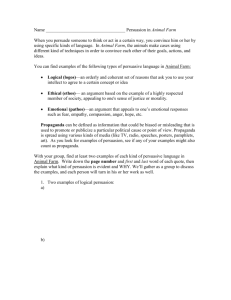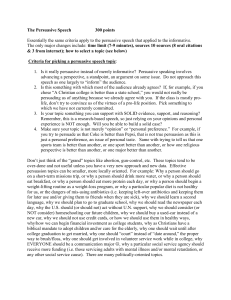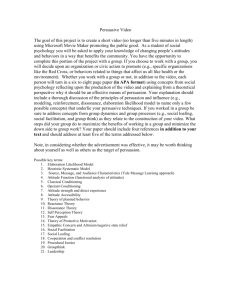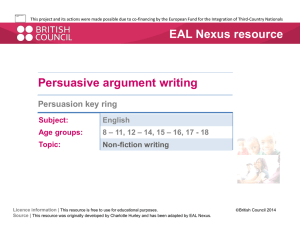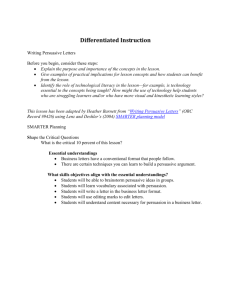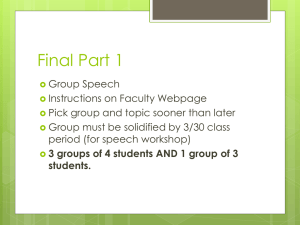1 Wille, Communication of Persuasion in Political Climates: New
advertisement
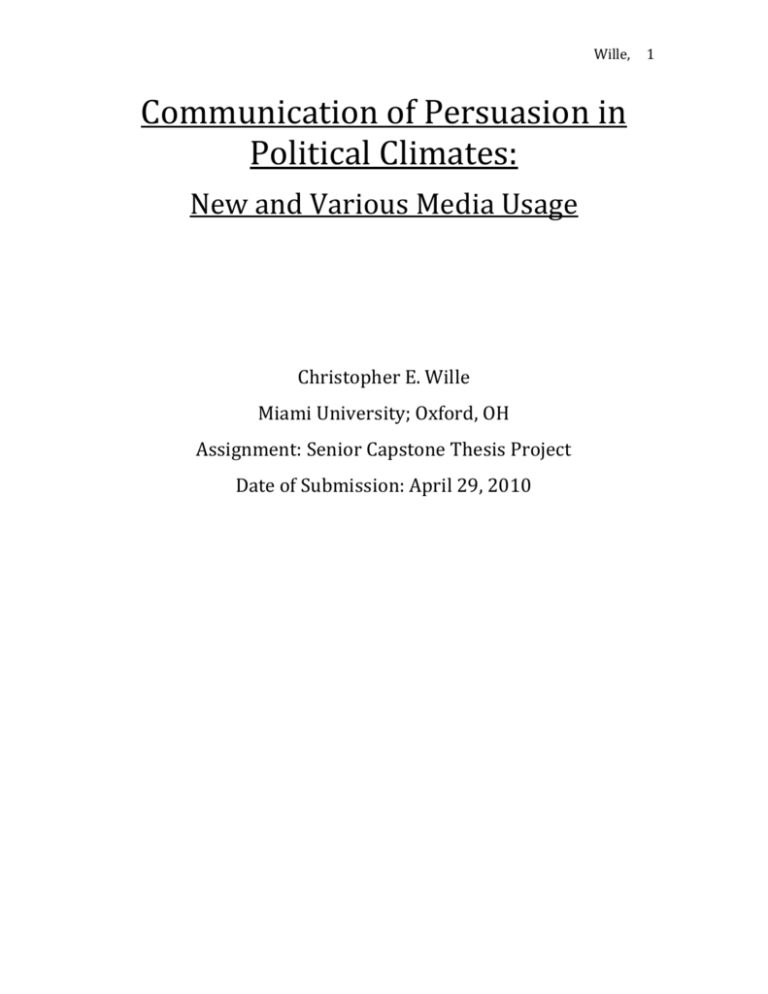
Wille, Communication of Persuasion in Political Climates: New and Various Media Usage Christopher E. Wille Miami University; Oxford, OH Assignment: Senior Capstone Thesis Project Date of Submission: April 29, 2010 1 Wille, Table of Contents: Title Page Author Certification page Acknowledgements Abstract List of figures, tables, and charts Section I Introduction Purpose Core Theory/Theorist Research Questions Research Type Section II Literature Review Yale Approach to Communications 1. scholarly journal article 1 2. scholarly journal article 2 3. book 4. textbook 5. news paper article Section III Secondary Research Propositions Personal Interviews, findings, conclusions Section IV Future research, and recommendations Value of supported propositions Future Research and links Section V Works Cited Formal Bibliography Appendix 2 Wille, 3 ABSTRACT The purpose of this research paper is to initiate a discussion involving the convergence of political communication and a communication theory of persuasion. This essay explores how the Yale Approach (Hovland, 1977) theory of persuasion can be interpreted in terms of how politicians communicate to their constituent bases. Secondary research design through scholarly research as well as personal interviews with congressional staffers allows for an interpretation of new media technologies, as well as the use of new social media, furthering the exploration of the various ways in which politicians can communicate using persuasive messages. Wille, CERTIFICATION OF AUTHORSHIP: I certify that I am the author of this assignment. Any assistance I received in its preparation is fully acknowledged and disclosed within this document. I have cited any and all sources, both print and electronic, from which I have used data, ideas, or words, either quoted or paraphrased. My cited sources are indicated within this document using APA format. I also certify this work was prepared by me specifically for this assignment as a requirement for this course. Student Signature Christopher E. Wille Date: April 29, 2010 4 Wille, 5 ACKNOWLEDGEMENTS First and foremost I would to thank my parents, Dr. and Mrs. R. Christopher Wille for their support not only financially, yet emotionally over my entire life, and especially over the last four years of college. Without their support, my college experience would not have been possible. I am forever grateful and indebted to them for their love and encouragement. I would also like to thank Miami University for providing me with the best four years of my life to date. Oxford, Ohio has become a second home to me and has helped shape the person I am today. I would also like to acknowledge my study buddy, Lindsay Wagner, for not only her assistance with my thesis, but also for her loyal and stoic friendship over the past four years- thank you Wagner! I also want to thank Mike Lewis for his help in being my mentor. I appreciate your time and expertise in my field of interest. I would also like to thank my friends for their continued encouragement and constant reinforcement. I would like to personally recognize Michael DeFisher for always believing in me, and reassuring me that no task is too big, no feat impossible, and that anything is possible. Last but certainly not least; I would like to thank Dr. Ronald Fetzer who made this entire thesis a possibility. Dr. Fetzer’s infinite wisdom of the field of communications, life lessons, and real-world experience has left a resounding impression on my life, and for his support and encouragement I am forever grateful. Wille, LIST OF FIGURES AND CHARTS (Buggey, 2007) (Buggey, 2007) Both of these charts are used to visually represent the concept that people’s perceptions of political ideologies mandates an affinity or preference to news channels that are perceived as having similar such ideologies or beliefs (Buggey, 2007). 6 Wille, 7 (http://www.psychology.uiowa.edu/classes/31106/Yale_approach_Lecture_ 6.pdf). This chart showcases a visual representation of Carl Hovland’s Yale Approach theory of Persuasion (1957). The chart outlines the various aspects of message interaction with the audience. The visual chart also recognizes the different influences on the message that shape audience perception. Wille, 8 SECTION I: INTRODUCTION From a personal standpoint, this thesis pertains to an area of interest that will likely be of use in future jobs and careers, as well as home and social life. The content matter of political and persuasive communication is not only relevant in the field of communications in the workplace; it is also being used on an every minute basis. Firm background knowledge and understanding of when and how to use the different and varied methodologies of communications will only serve to enhance an organization’s or an individual’s credibility. An appropriate use of persuasion within political communications can ultimately foster a greater understanding and welcoming constituency that can henceforth provide a successful campaign resulting in election. The new- age era of electronic and digital communication via web-based technologies has quickly become second nature to generations in the workplace. This familiarization has also taken a quick hold of the political climates that induce this nation, The United States, and its people with pop-culture and its obsession with all things instantaneously gratifying. News, language, information, as well as the spoken and written word now travel at speeds across the Earth faster and with more accuracy than ever before. There has been a ubiquitous alteration in the way in which Americans receive their information over the past number of years, many of these changes stemming from the development of a digital infrastructure and Wille, 9 computer technologies. From the mid-20th century onward, presidential, senatorial, congressional, gubernatorial, and also local elections have been broadcasted mainly through television advertisements and debates, however in the 21st century dramatic alterations have been noticed. Wednesday October 5th, 1988 marks the date in which Sen. Lloyd Benson critiqued his opponent, Sen. Dan Quayle, during a vice-presidential debate, stating, “Senator I served with Jack Kennedy. I knew Jack Kennedy. Jack Kennedy was a friend of mine. Senator, you’re no Jack Kennedy,”(The Washington Post. October 6, 1988). This rancorous comment by Benson triggered an immediate distinctive amount of media buzz which was seen both in print and television form. The banter between the two candidates stirred commentary as political analysts and television journalists played and replayed the audio-visual clip for the world to view and hear repeatedly. Today, all one has to do in order to access this media clip is type, “you’re no Jack Kennedy,” into any Internet search engine and the YouTube video of the debate is found. This ease of access to events that have occurred in the past is a direct translation of media’s effect on how accessibility has changed altogether. Visit this link to view the clip: http://www.youtube.com/watch?v=uWXRNySMW4s Wille, 10 CORE THEORY and THEORIST: What comes with this newfound ease of access? What has changed about the way in which national political climates communicate to constituents? One thing is for certain however, political communication has and continues to have intentions of which include message persuasion and information. This standard for persuasion is illustrated by the persuasion theories of communication. The persuasion tactics used in the 1988 vice-presidential debate are a direct translation of the types of communication tactics practiced for years. In watching the video, the use of both verbal and nonverbal communication patterns become integrated within the theories of persuasion for political communication; as illustrated in one such theory of persuasion, the Yale Approach (Hovland, 1953). This theory in accordance with the following research questions (RQ’s) will attempt to explain the connection between theory and practice of persuasion within political communication. RQ1: How/ why is the staff’s use of technologies critical in campaigning? RQ2: How do the theories of persuasion support the varied use of techniques used in running for political office? RQ3: How well does staff training relate to a successful political campaign outcome? Strategies and techniques included? To understand more about how these RQ’s are integrated into political communication, background knowledge of the theories is needed. The Yale Wille, 11 Approach theory of persuasion was developed as Carl Hovland performed a study in which, “The relationship between the attitude of the recipient and the position advocated in a communication was studied under conditions where a communicator not known to subject presents a point of view on a controversial issue which differs from that of subject by varying amounts,” (Hovland, 1957). The studies’ results indicate that when a subject is presented with a controversial topic matter, they are likely to produce a response indicative of their own personal biases towards the matter (Hovland, 1957). These findings, when applying them to the persuasion tactics of politicians, undoubtedly relate. The breadth of differences between a subject’s attitudes along with their overall distance between acceptance and rejection “may provide a basis for predicting reactions to communication and susceptibility to change,” (Hovland, 1957). This susceptibility to change is what politicians’ bank on. This research proves that when an audience is confronted with an opposing vantage point, they become inherently predictable in their reactions. This predictability therefore allows political communication analysts to foretell differing levels of acceptance of topical arguments in political constituencies. This knowledge henceforth pertains to the message a politician should communicate; i.e. how strongly an audience feels one way or another about the topic of discussion will ultimately determine the level of aggressiveness he or she needs to foster in order to Wille, 12 convince an audience of his or her claim. However, how a politician develops this claim is subjective and can change over time. The Yale Approach (1977) to persuasive communications theorizes that there are four separate components to persuasion: attention, comprehension, acceptance, and retention (Frymier, 2010). The Yale Approach to persuasion is directly tied to political communication in that it attempts to explain the differing ways in which persuasion messages reach audiences, how they are disseminated and then consumed. As Frymier indicates, “attention refers to getting the audience to focus on the message,” (Frymier, 2010). Because of the constant bombardment with many messages everyday, there is a constant battle for the attention of an audience. Due to thousands of competing messages, people often engage in what is called selective attention and perception, which involves the process of paying attention to messages that are more important or useful to the individual (Frymier, 2010). Once the audience receives the message, the next most important issue is whether the audience can comprehend and understand the message. In order to do so, the sender of the message (i.e. a politician in this case) must provide “clear explanations and simple messages,” (Frymier, 2010). In understanding these concepts, politicians can mold their message to express that their message is important and will impact the daily lives of constituents in order to gain more of the audience’s attention. The audience’s attention along with mutual comprehension of the message will foster the next level of The Yale Approach. Wille, 13 The next latitude of The Yale Approach includes acceptance of the message. This level of the approach is most difficult as it ultimately decides whether or not the persuasive communication has changed the audience in terms of attitudes, beliefs, behavioral intentions, and behaviors (Frymier, 2010). The goal of a persuasive message, especially in times of an election, includes all of the behaviors mentioned above. If a successful message were to be used, then the politician would have gained support of the audience he or she was trying to persuade. Factors such as speaker credibility and overall message credibility directly influence the audiences’ perception of acceptance of the message. As Frymier indicates, sources high in credibility were often more successful in achieving message goals than sources of low credibility who were less successful in message acceptance. The final stage of the Yale Approach is called retention. This component of the theory is very influential for politicians as while they can inform and persuade an audience, their message will ultimately not be meaningful if the audience doesn’t retain the message meaning. It is important for the source of the message to produce a message that will remain memorable over time. The retention of the message will in turn be the final judgment of whether or not the persuasive message is deemed successful (Frymier, 2010). The influence of outside factors on message and message retention complicate the process of message delivery and memory. Furthermore, when considering the basic models of communication such as the transactional and interaction models, noise, known as interference, can impact the ability of a message to get to the receiver. Noise and message complication are two components that Wille, 14 complicate the process of politicians sending messages to audiences (Bennett, 2010). Another issue that the Yale Approach does not account for in terms of messages reaching or not reaching audiences is that people are often distracted by both internal and external noise. The ability of people to self-select their own personalized information has impacted a politicians ability to influence their audience. The process of self-selecting media suggests that “the problem is that as individuals become both harder to reach with exogenous inputs and more likely to dial up their own reinforcement, the process has changed,” (Bennett, 2010) meaning that people not only gather their own media, they also reinforce their own ideas, thoughts, and opinions based on their personal selection. The Internet, niche websites and various other new media allow for personalized news and information to matriculate to every individual based on their preferences. This personalization henceforth creates newfound issues for politicians as their message can easily avoided by uninterested constituents. This again makes message dissemination ever more difficult for political hopefuls as these personalized representations of media serve to uphold previous values and do not necessarily account for opposing vantage points that would win sway voters at the polls. The fact that people actively engage in attitude positive reinforcement versus negative reinforcement poses ever increasing battles for media attention and forces politicians to actively pursue new and creative methods of message persuasion (Bennett, 2010). Other such influences in the inability of politicians to reach differing versus target audiences can be again attested to audience perception and individual media choices. Findings conclude that, “demand for news varies with the perceived affinity Wille, 15 of the news organization to the consumer’s political preferences,” (Iyengar, 2010). This again infers the notion that an audience member is more likely to prefer media that reinforces their own personal biases, and avoid information that is not in concurrence with their views. This article also elicits that the media tends to showcase extreme polarization of political ideologies that politicians also tend to polarize themselves in order to align with the media’s representation of political activists who are also indicative of that polarized state (Iyengar, 2010). Because media in general and television in specific tend to place emphasis on information and news that their audiences find interesting, polarized perspective tends to be entertaining especially when two opposing opinions are debated. Iyengar goes on to argue that the mass audience of consumer’s attitudes has mirrored this polarization. The reasoning behind this mirrored image of extreme opposing doctrines both in the media and the public is directly correlated to the technological revolution. There has been a wide expansion in the breadth of media outlets available to the general public since the early days of television and radio (Hendy, 2010). This increase in the number of media provides means for more diverse perspectives available for consumption. As discussed by the Yale Approach theory, there is a constant battle for attention, as in today’s world people are constantly bombarded with multiple messages at once. Following this concept, the increase of messages due to the increased number of media available because of the technological revolution has therefore made it more difficult for outlets to gain and maintain there audiences attention. This difficulty gaining audience attention has resulted in the dramatization of messages (Iyenger, 2010) over time. The heuristic quality of the Wille, 16 Hovland theory has proven worthy; as in the 1970’s when the theory was crafted, there were roughly three main newscasts that allowed American’s to get their news (Iyenger, 2010). Today, the 24-hour news cycle, alongside of new media outlets such as the Internet have fostered even more competition for attention and in turn have created a resurgence of selective media exposure. The very same process of selective attention as defined in the Yale Approach, subjugates the reasons for which individuals manifest media outlets that coincide with their personal biases as stated by the concept of positive reinforcement (Bennett, 2010). Considering an individual’s personal biases dictate what type of programming he or she will ultimately consume, the media and in turn politicians, have become polarized in order to gain the attention of these people. The audience usually only becomes attentive when the messages are dramatic and entertaining and also correspond with their own attitudes. Politicians now have a harder time trying to gain and sustain an audience’s attention not only due to the sheer number of alternative messages, but also because audiences are often divided as they undergo the process of self selection of individualized media. This point henceforth dictates the need for politicians to emulate the news media’s ability to capture audience attention via dramatized content of extreme polarized political analysts (Iyengar, 2010). Because these analysts are able to capture audience attention through the polarization of ideologies, politicians can in turn use these concepts as a footing to build their diplomatic persuasive messages. With political and ideological extremist views at the center of the American audience’s attention, the politicians who emulate such Wille, 17 views will undoubtedly gain more media and audience attention, and will likely be more able to impact message acceptance and memory, which are the ultimate goal of persuasive messages. SECTION II: LITERATURE REVIEW The Shifting Foundations of Political Communication: Responding to a Defense of the Media Effects Paradigm W. Bennett This article printed in the Journal of Communications in 2010 illustrates an example of a scholarly journal article. The article is important as it attends to the need of constant measurement of media audiences and takes into account the shifting paradigms taking place. The article provides an update on the previous findings of researchers on the subject matter of audience response to political communications when subjected to messages of persuasive communication. Other communication scholars subjected the author’s original article to critical analysis and this article responds to the need to clarify findings and update them as well. The article also highlights the heuristic nature of the field of political communications in regards to persuasive theories of communications. This article assisted in answering the following research questions, “How/ why is the staff’s use of technologies critical in campaigning?” as well as, “How do the theories of persuasion support the varied use of techniques used in running for political office?” The former question was supported by the author’s claim that, “the tendency to select news based on anticipated agreement was also strengthened among more politically Wille, 18 engaged partisans,” (Bennett, 2010) meaning that upon staff’s integration of persuasive message, the use of technological type should be integrated into the plan of discourse. The latter question was answered through this article’s assertion that there is a continuing tendency of individualized self-selection of media, which directly affects the ability of political messages to shape political attitudes. This selfselection of media is included in the Yale Approach theory of persuasive communications, and this article helps tie the concepts together. Red media, blue media: Evidence of ideological selectivity in media use Shanto Iyengar, and Kyu S Hahn This scholarly article also found in the Journal of Communications, explores the ways in which audience is impacted by political messages using persuasive tactics. The article explores the various was in which politicians disseminate messages to the public, and how they target individuals based on ideological preferences. The article also explains how personal affinity to political party ties dictates their media usage. The article suggests that selective exposure plays an integral role in how audience members receive their news and information through the media. This article assisted in answering the following research question, “How do the theories of persuasion support the varied use of techniques used in running for political office?” as it lent real-world findings of audience preferences. Based upon the knowledge of audience tendencies, a politician will be able to understand how to better utilize the methods of persuasion in preparing a message. This article also helped answer, “How/ why is the staff’s use of Wille, 19 technologies critical in campaigning?” as it incorporates the various reasons as to why audience members access certain substitutive media. This knowledge henceforth allows staffers to appropriate differing media in order to reach audience members based on their varied media preferences. Resistance and Persuasion Eric Knowles and Jay Linn This book lent a perspective of persuasion in regards to its opposing viewpoint of resistance. The book asserts that in order to fully accomplish the task of persuasion, one must first understand the precursors that prevent persuasion from occurring. The book details methods for reducing message resistance by presenting strategies, insights, and new and different methods of persuasion influences. The book outlines that persuasion can be fully achieved by reducing resistance based upon these methods, “training people to be appropriately resistant, postponing consequences to the future, by focusing resistance on realistic concerns, by fore-warning that a message will be coming, by simply acknowledging resistance, by raising self-esteem and a sense of efficacy, and by consuming resistance,” (Knowles, 2004). These important concepts of resistance and persuasion helped to answer the question of, “How well does staff training relate to a successful political campaign outcome? Strategies and techniques included?” as the book encompassed new and varied strategies and techniques of persuasion. Persuasion: Integrating Theory, Research, and Practice Ann Frymier & Marjorie Nadler Wille, 20 This textbook discusses the various theories of persuasion, and different chapters tend to focus on the various methods for the creation of a persuasive message. Chapter four heavily dedicates itself to discussing the Yale Approach, which helped formulate a basic guideline for which to understand this specific method of persuasion. This college textbook lends perspective of university professors in an attempt to coagulate the value of the theories as well as in practice. The textbook explains the theories from a communications perspective and helps to place the emphasis on how the theory relates to the actual practice in the field. The five theories presented also integrate application and examples of how and when to use the different aspects of the theories in terms of persuasive message. This book helped to outline persuasive communication in terms of political communication, as it heavily discussed the ability of persuasive messages to influence the attitudes, values, and beliefs of the audience. The outline of the Yale Approach theory helped to create an understanding of the predispositions of individual audience members, and factors that influences their ability to be persuaded through messages. JFK Reference Transforms Debate. David Broder This article was utilized, as it is an example of a primary reaction to a political communicative message that transformed the debate of persuasive messages in the 20th century. This newspaper article dating from October of 1988 explores the reactions to and from a vice presidential debate that would ultimately transform and inspire interest in a presidential campaign in the United States that previously was not interesting to the majority of the American audience prior to the Wille, 21 debate. This article also recognizes how media played and replayed the debates highlights as the American audience became ever more interested in the dramatic entertainment that occurred during the debate. This article truly encapsulates the concepts in the Yale Approach of individual self-selection of media and well as audience attention and retention of messages. This is also a real-world example of the theory in practice in American history. This article helps to prove the heuristic practice of theory in its application and understanding of real world issues. Wille, 22 SECTION III: SECONDARY RESEARCH & PERSONAL INTERVIEWS, FINDINGS, CONCLUSIONS Sections I and II of this essay focus on correlating a core theory of persuasion, the Yale Approach, in regards to political communication. This section will focus on the type of research that will contend to prove the propositions of the research questions, as sub-set points via the use of personal interviews with the support of secondary research. Theorists, researchers, and students utilize differing components of research in order to prove their arguments. This thesis was written using secondary methods of research, which allow for a conglomeration of theorist and researcher thoughts to be analyzed in order to prove both the research questions, as well as propositions. The typology of research meant to prove the hypotheses and propositions (P) below is inclusive of secondary research, yet interviews also help to provide concrete evidence to support the claims provided by scholars as proven by the research questions in Section I. Rather, this section of the thesis specifically consists of personal interviews with congressional staffers of Congressman Mike R. Turner [R-OH-03] in order to explore the following statements. The first research question elicits the idea that technology, and a political staff’s use thereof will be a deciding factor in political campaigning. Research suggests that this hypothesis is undoubtedly true. Wille, 23 P1: Politicians must use avenues of new social media including new and different methods such as Facebook and Twitter in order to be elected today. P2: Politicians use varying media in order to connect with different media markets. P3: Persuasion techniques differ based on the people the politician is trying to persuade or influence. New social media such as the Internet, Facebook, YouTube, Twitter, LinkdIn, and many more have allowed politicians to reach an audience much different than in prior years. However the ease of accessibility, as well as the ease of disseminating a large message to a mass number of people and at a low cost to the sender, does not come without repercussions. Twitter has caused many problems for a number of politicians. The premise of Twitter includes that messages, Tweeted out to followers, must not exceed 140 characters (Twitter.com). This brevity of letters poses a threat to some politicians whose status quo oftentimes includes longwinded speeches. For some congressmen of the U.S. House of Representatives, boiling down their messages to only 140 characters has proven challenging as their messages often are detailed and extensive (Wehrman, 2009). However, politicians have quickly been adopting these new forms of social media at exponential rates, including House Minority Leader John Boehner [R-OH] who now holds two Twitter accounts and updates them regularly (Wehrman, 2009). This section of the essay will now explore these propositions in terms of a staffer’s approach in working with media in a United States congressional office. Wille, 24 Behind each and every United States Congressman there is a staff of individuals who work in unison in order to convey a message to the world. Usually the message is determined initially by the individual congressperson; however as time progresses, those very staff members gain voice in the body that is the US Congress. Staffers lend their minds to the goals of the individual Congressperson upon agreement of employment, and those staffers often alter their own voices in order to reach into the mind of their boss in order to learn his or her every thought. As those staffers learn more about their boss, they begin to insert their own initiative and perspective of what the congressperson believes into their work. With time, a staffer can predict their boss’ opinion on a matter and can use their own judgment to develop the congressman’s voice in their writing. Writing on a congressperson’s behalf is a task that is quite common. Often a congressperson approves what his or her staff is writing about after the piece has already been dictated. Ultimately the message is drafted by a staff member and approved by the congressman himself; such is the case for Congressman Mike R. Turner (R-OH). Michael C. Lewis is Congressman Turner’s senior policy advisor as well as his Speechwriter. Through interviewing Lewis, it became apparent that his boss is “almost always involved in every aspect of any message or form of communication,” sent through his Washington DC congressional office. As his speechwriter, Lewis describes his job as a sort of “hybrid” position that includes a variety of skills and expertise. He specializes in writing a variety of floor speeches, weekly columns, press articles, policy issues, and also letters to members of President Obama’s administration including Secretary of Defense, Robert Gates. Lewis also describes Wille, 25 his position as a “floating staffer,” which includes coordination between the Chief of Staff, the Legislative Director, the Press Secretary, and most importantly the congressman himself. Lewis explains that the congressman is involved in almost every aspect of any message or communication involving a constituent or the media. Lewis stated that Turner dictates all topics of press releases and often devises a media strategy on his own. Lewis noted that it is possible because of the congressman’s extensive history in working as the Mayor of Dayton, Ohio, along with his current position as a senior congressman, that he has learned how to work with the media quite well. He mentioned that Congressman Turner’s wife Lauri is a “PR [public relations] expert and often she can help influence strategy.” Many congressmen employ extensive staffs, many of public affairs authority, in order to engage in media and constituent communication and, “Turner is included in that he also employs press and communication staff,” states Lewis. He notes that other congressional offices leave “strategy to the staff with a congressman’s approval.” The subject matter of communication and key messages alters with every congressional office. Oftentimes the policies and therefore messages a congressperson uses are shaped through their personal constructs along with direct influence from their constituents. Often the messages of one congressional office are quite different from that of another, frequently across party lines, yet more rarely within a party. Telly Lovelace, another of Rep. Turner’s staff as his Press Secretary and Communications Director, explains strategy for communicating with a national Wille, 26 audience. Lovelace explains that the “relationships with the media are built over time.” Lovelace continues in that he “works off of the relationships that my predecessors to this position have built.” Lovelace mentions that with issues pertinent to national attention the media targeted often changes. He explains that, “radio shows, TV networks such as Fox are often who we send our news to,” when issues are of national importance. Lovelace comments that the constitutional amendment is pushed on a national level because it “gets constituents to call their congressmen and puts pressure on them to co-sponsor the amendment.” The case for local issues is much different, Lovelace explains, “the target media for local news are of course, The Dayton Daily News, local TV and radio, WHIO, WDTN, and in the lower counties, the Franklin Chronicle, and the Wilmington News Journal amongst others.” When drafting and writing a press release, one of Lovelace’s main duties, he works together with other staffers such as the Legislative Director and Mike Lewis in order to tailor the best message. All members of the staff are informed of a press release via e-mail before it is sent out to the media, however the congressman himself is ultimately the one who approves any press release before any member of the media receives the message. As Lewis suggested during his interview, Lovelace agrees that Rep. Turner is very pro-active in working with the media. Lovelace suggests, “ Many of our media relations are because of the congressman; because of his long-term involvement in the district.” Other areas of influence for media strategies come from the leadership of the party. The GOP conference has weekly meetings to discuss the week’s events and messages that Republican offices should present to their respective media and Wille, 27 constituents. Lovelace explains that the GOP conference provides sample press releases that he uses as a rough outline to shape Rep. Turner’s messages. Some of the larger issues such as cap and trade, auto takeover, and healthcare reform are issues that the party as a whole tries to agree on in order to have a united front, Lovelace states. He also mentioned that these issues have a more key and target message that Turner tries to adhere to as long as he agrees with it. Lovelace suggests that Turner always has his “own opinion mixed in with the sample releases. The district mandates how or if Turner will agree.” Other conferences, such as the Republican Study Conference (RSC), send out press releases or sample messages but ultimately the decision to use them or not are in the hands of the individual congressman. Lovelace, throughout the interview, also explored the new and changing climates for communication between congressional offices, the media and constituents. There is an expanding use of technology within Congressman Turner’s office. Rep. Turner has his own Facebook page where he updates issues, statements, and upcoming events on a daily basis (Facebook.com) On this page there are links to YouTube videos where Rep. Turner is making floor statements. There are also links to press releases, media articles and many other media links. Friends of Turner can post comments and voice their opinions on the subject matter presented. This form of communication is expanding as now over 1371 people follow the congressman via his Facebook page. Another technological development that Lovelace comments on as “cutting edge” is his use of Tele-Town Halls. According to Tele-Town Hall’s website, “Tele-Town Hall utilizes a patent-pending mass automated variable speed Wille, 28 dialing system with a voice over IP (Internet Protocol) connection to dial out to thousands of phone numbers from a pre-selected list at a fraction of the cost of other forms of communication,” (teletownhall.com) Rep. Turner has used this format in order to communicate with a mass audience from Washington to his representative district. Lovelace explains that these new methods of communication are “ cost-effective, efficient, and instantaneous.” Lovelace also ascertains that new methods of communications such as an extensive e-mail list of over “6,000 e-mail addresses within the district,” have helped to ease communication between the audience and the congressman. However, Lovelace explains that the office is hesitant in using even newer arenas such as Twitter because of the “constant need to update,” and Lovelace suggests that, “ Once you start Twittering you can not stop. It’s an uphill battle after that.” Others agree that Twitter is challenging as an article in the Dayton Daily news suggests; “ For lawmakers used to windy speeches on the floor of the House of Representatives or the U.S. Senate, it’s got to be something of a challenge: Boil down your comments to a sentence or two, then post them online for “followers” to see,”(Wehrman, 2009) Either way, new forms of communicating messages from congressional offices are constantly changing, and as the article, “Blog Posts Are the New Press Releases,” suggests, new message media portrayals are making stale the previous conventions of press releases (johnathanrick.com). Wille, 29 SECTION IV FUTURE RESEARCH & RECOMMENDATIONS As my research questions, hypotheses, and propositions indicate, there will continue to be expansion and change in the realm of political communication, media usage, as well as persuasive techniques and their effectiveness. The heuristic value of the Yale Approach method of persuasion suggests that it will continue to be way in which scholars and students understand persuasive communication. Its application to real-world structures has proven its value and reasons for continued study. The everchanging climates of new media with the adoption of different technologies will likely force the Yale Approach to be adopted from time to time, yet the premises for which it is based contend for a long and sustainable future. Future research in the field of study will likely continue as communication climates and individual values continue to change. The self-selecting process of information is one of the most notable influences that has changed the way in which politicians are able use persuasive messages in order to communicate with their constituent bases. The ever-changing audiences in conglomeration with new and different technologies have created a cyclical influence that will likely continue well into the 21st century and onward. Wille, 30 A personal suggestion I would have for future media change would be to study Apple’s influence of the way in which audiences access information. With the Apple Company’s influence of “i-technology,” the entire process of self-selection is utilized in order to co-create an individualized component to technology. With the Apple company’s revenues increasing to $13.5 billion U.S. dollars this quarter of 2010, during a time of a recession, in comparison to its $9.08 billion dollars in revenues from last year, the influence of growth of the company has proven to be of want and desire to the American public, and increasingly the entire world (apple.com). The ever-increasing product line that Apple boasts has created an undying interest in personalized products, as showcased in Apple’s latest creation, the iPad (apple.com). Based on my findings I would argue that technological products that allow for personal selection of use will continue to be of distinct interest to the American audience, who value personal success and gain in this individualistic culture. Thus, it is inevitable that politicians would benefit from investing in utilizing such information in the dissemination of their persuasive messages in order to appeal to the new and changing demographics of such an audience. Wille, 31 SECTION V WORKS CITED Apple Reports Second Quarter Results. Accessed 4/25/10 from: < http://www.apple.com/pr/library/2010/04/20results.html >. Bennett, W., & Iyengar, S. (2010). The Shifting Foundations of Political Communication: Responding to a Defense of the Media Effects Paradigm. Journal of Communication, 35-39. Buggey, T. (2007, Summer). A Picture Is Worth. Journal of Positive Behavior Interventions, 9(3), 151-158. December 14, 2007. Broder, David. JFK Reference Transforms Debate. October 6, 1988. The Washington Post. Congressman Mike R. Turner’s Facebook Home Page. Last accessed 4/19/10. < http://www.facebook.com/RepMikeTurner?ref=ts > Frymier, Ann & Nadler, Marjorie. (2010). Persuasion: Integrating Theory, Research, and Practice. Volume two. Dubuque: Kendall Hunt. Hendy, D. (2010). Listening in the Dark. Media History, 16(2), 215-232 Hovland, Carl I.; Harvey, O. J.; Sherif, Muzafer. Assimilation and contrast effects in reactions to communication and attitude change. The Journal of Abnormal and Social Psychology. Vol 55(2), Sep 1957, 244-252. How Tele-Town Hall Works. Last accessed 4/19/10. < http://www.teletownhall.com/How-it-Works.html > Hovland, C. I. (1954). Effects of mass media of communication. In G. Lindzey (Ed.) Ch. 28, 1062-1103, Handbook of social psychology. Cambridge: Addison-Wesley, 1954. Iyengar, Shanto, and Hahn, Kyu S. (2009). Red media, blue media: Evidence of ideological selectivity in media use Journal of Communication. 59 (1, March), 19-39 Wille, 32 Knowles, Eric & Linn, Jay. (2004). Resistance and Persuasion. Mahwah, New Jersey: Laurence Erlbaum Associates, Publishers. Personal Interviews. (Mike Lewis and Telly Lovelace. July 20, 2009). Rick, Jonathan. No Straw Men. Blog Posts Are the New Press Releases. 4/19/10. < http://jonathanrick.com/> “The Yale Approach to Attitudes: Cognitive?” Last accessed 4/27/2010 from < http://www.psychology.uiowa.edu/classes/31106/Yale_approach_Lecture_6.pdf >. Wehrman, Jessica. Using Twitter a challenge for area politicians. Dayton Daily News, July 20, 2009. FORMAL BIBLIOGRAPHY Bicket, Douglas, and Wall, Melissa (2009). BBC news in the United States: A 'superalternative' news medium emerges. Media, Culture & Society. 31 (3, May), 365-384. Cohen, Jonathan, and Tsfati, Yariv (2009). The influence of presumed media influence on strategic voting Communication Research. 36 (3, June), 359-378. Iyengar, Shanto, and Hahn, Kyu S. (2009). Red media, blue media: Evidence of ideological selectivity in media use Journal of Communication. 59 (1, March), 19-39 Norton, Todd (2009). Situating organizations in politics: A diachronic view of control-resistance dialectics. Management Communication Quarterly. 22 (4, May), 525-554 Townsend, Rebecca M. (2009). Town meeting as a communication event: Democracy's act sequence. Research on Language and Social Interaction. 42 (1, January), 68-89. Vishwanath, Arun (2009). From belief-importance to intention: The impact of framing on technology adoption Communication Monographs. 76 (2, June), 177-206 APPENDIX A. Title Pages and Introduction (pp.1-9) B. Core Theory (pp. 10-16) C. Literature Review (pp.16-20) D. Secondary Research (pp.21-28) E. Future Research and Recommendations (pp. 28-29) Wille, 33 F. Works Cited, Formal Bibliography and Appendix (pp. 29-31)


